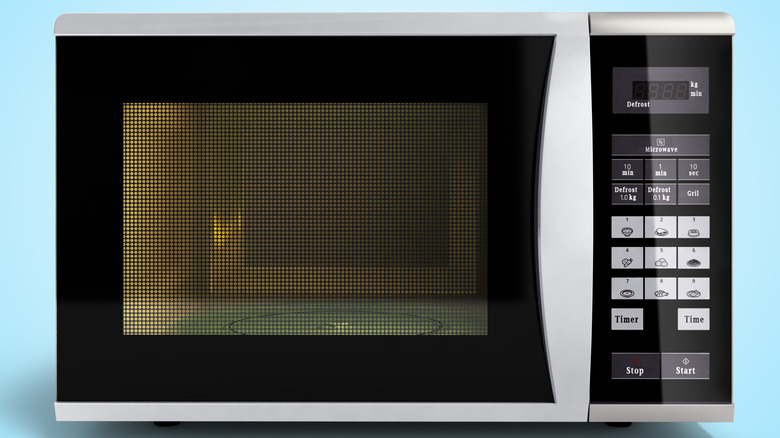The Reason Your Microwave Door Has A Mesh Grating
If you've ever tried to keep an eye on your mug cake or melting chocolate in the microwave, you might have found that the dense mesh makes it pretty hard to see inside the appliance. Inconvenient as it might be, the mesh is there for an important reason: It keeps the microwaves from escaping the oven through the glass.
Hopefully, you already know that microwaves can't pass through metal, and that's why you should always check for any kind of aluminum or other metals on food containers before putting them in the microwave. It's also why all sides of the microwave oven are closed in with metal, and the mesh on the door forms the front-facing part of the enclosure. These kinds of barriers are called Faraday cages, which is really just a fancy way of describing cages that either trap or keep out electromagnetic waves.
However, it's worth noting that the Faraday cage in your microwave is designed specifically for microwaves. While this invisible radiation might seem scary, the truth is that microwaves aren't visible to the human eye for the opposite reason from extremely dangerous radiation like gamma rays: Their wavelengths are so long and low-energy that they fall below the threshold for visible rays. Believe it or not, the little holes in your microwave oven's mesh are actually smaller than microwave rays, effectively keeping them in while letting visible light go out so you can see your food.
You'll find mesh on conventional ovens for similar reasons
Now you might be wondering: If the grate on a microwave oven door is specifically designed to trap in microwave rays, why do conventional ovens also have some kind of polka-dot pattern or mesh covering over the window? The short answer is that conventional ovens need just as much insulation as microwaves do, and the covering is there to protect the door.
Conventional ovens work with an incredible amount of heat that's just as hazardous as microwave radiation, if not more. If left unprotected, the glass on any conventional oven door could shatter from the heat and potentially cause serious injury. That's why you'll find mesh or painted black dots on the glass — the dark material absorbs and reflects heat, keeping the high temperatures safely inside. The reason why they look so similar to microwave oven meshes, despite radiation and heat operating on different physics principles, is pretty simple: Ultimately, perforated coverings just happen to be the best compromise between insulation and visibility.

